Physical Address
304 North Cardinal St.
Dorchester Center, MA 02124
Physical Address
304 North Cardinal St.
Dorchester Center, MA 02124
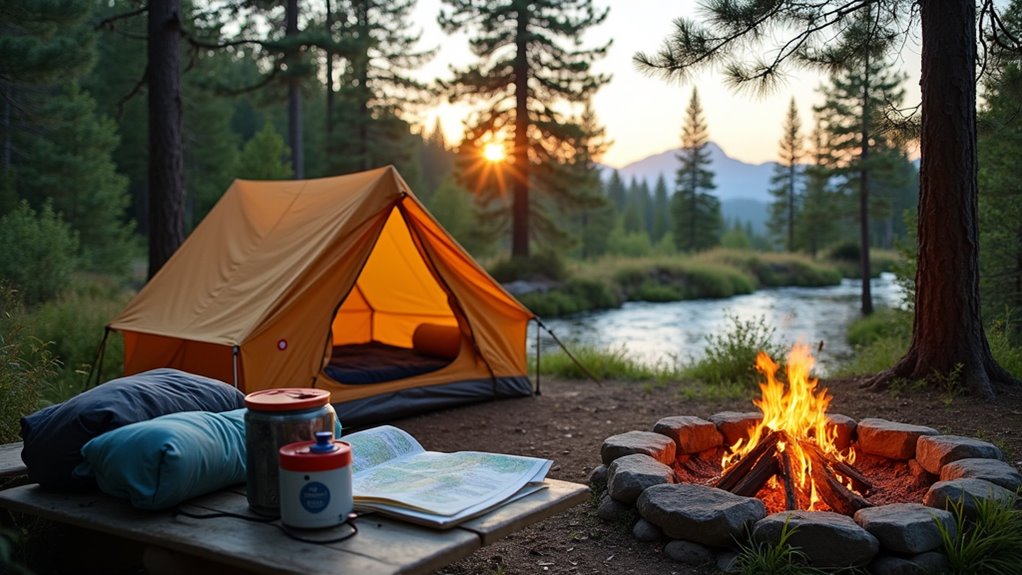
Smart camping strategies can transform your outdoor adventure from disaster to dream—discover these 12 essential tips that experienced campers swear by.
Picture yourself around a crackling campfire under a canopy of stars, feeling completely at peace in nature’s embrace. You’re probably dreaming of that perfect camping experience, but the reality is that successful trips don’t happen by chance—they’re the result of smart planning and preparation. Whether you’re a first-time camper or looking to improve your outdoor skills, there are specific strategies that’ll transform your next adventure from potentially stressful to absolutely unforgettable.
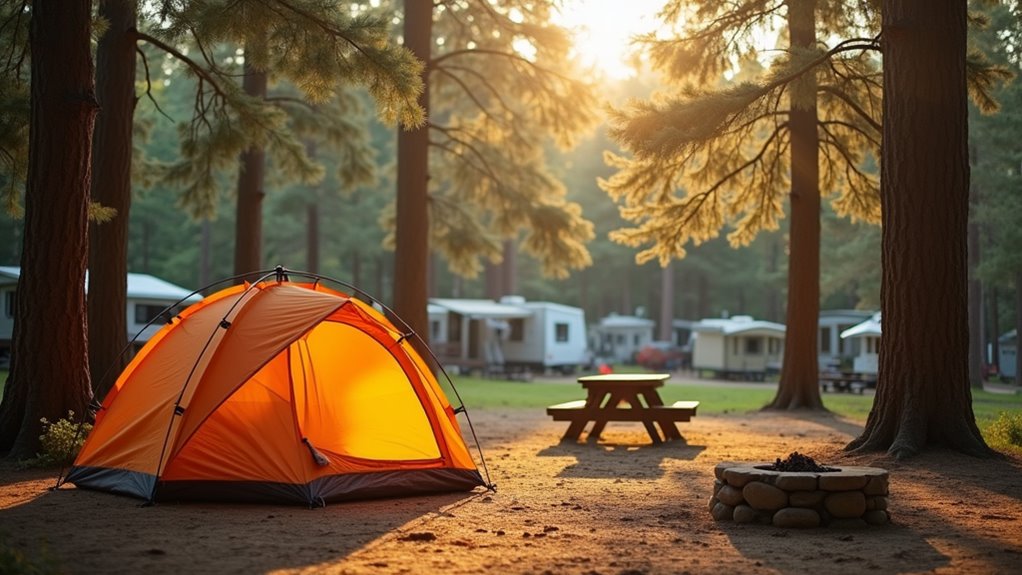
Before you pack your sleeping bag or plan your campfire menu, you’ll want to secure your spot in the great outdoors. Popular campgrounds fill up quickly, especially during peak seasons and weekends. Start researching campsites at least two months ahead of your trip.
Check park websites, read reviews, and compare amenities like restrooms, water access, and fire pits. Consider your camping style—do you need RV hookups or prefer primitive sites? Look at site maps to avoid spots near busy roads or bathrooms if you value quiet.
Make reservations as soon as they open, which varies by location. Some parks accept bookings six months in advance, while others operate first-come, first-served. Having backup options prevents disappointment if your first choice isn’t available.
When evaluating potential locations, focus on finding the perfect campground that matches your specific needs and preferences for an optimal outdoor experience.
When you’re miles from the nearest hospital, a well-stocked first aid kit becomes your safety net. Don’t just grab a basic bandage box and call it good.
Miles from help, that basic bandage box won’t cut it—your wilderness first aid kit needs to be your complete safety lifeline.
You’ll need antiseptic wipes, gauze pads, medical tape, pain relievers, antihistamines, and tweezers for splinter removal. Include blister treatment since hiking boots can wreak havoc on your feet.
Pack any personal medications you take regularly, plus extras in case your trip extends unexpectedly. Add instant cold packs for sprains and a thermometer to monitor fevers.
Store everything in a waterproof container and label it clearly. Check expiration dates before each trip and replace items as needed.
Your future self will thank you when minor injuries don’t derail your adventure. Consider building a complete wilderness survival kit that includes your medical supplies alongside other essential emergency gear for more serious situations.

As darkness falls in the wilderness, your safety depends entirely on having reliable illumination. Don’t rely on a single flashlight—pack multiple light sources to avoid being stranded in darkness. Bring a headlamp for hands-free activities like cooking or setting up camp, plus a backup flashlight and small LED lantern for your tent.
Your phone’s flashlight won’t last long, so don’t count on it as your primary source.
Pack more batteries than you think you’ll need. Cold temperatures drain battery life faster, and you’ll use lights more than expected. Store spare batteries separately from your devices to prevent accidental drain. Consider rechargeable options with a portable power bank for longer trips.
Test all equipment before departing to ensure everything works properly. For maximum preparedness, consider investing in a compact survival kit that includes emergency lighting tools alongside other essential gear.
Building a campfire requires more than just throwing logs together and hoping for the best. You’ll need three components: tinder, kindling, and fuel wood.
Start with dry tinder like birch bark or pine needles, then add pencil-thin kindling, gradually working up to thumb-sized pieces. Once flames establish, add larger fuel wood.
Always clear a ten-foot radius around your fire pit, removing flammable debris. Keep water and dirt nearby for emergencies.
Never leave your fire unattended, and ensure it’s completely extinguished before sleeping or leaving camp. Stir the ashes, add water, and stir again until everything’s cold to touch.
Practice fire-building techniques at home first. You’ll feel more confident when you’re tired and hungry at your campsite.
If you’re using lightweight tent trailers for camping, you’ll have the advantage of easy setup and mobility while still enjoying the authentic outdoor experience of campfire cooking and warmth.
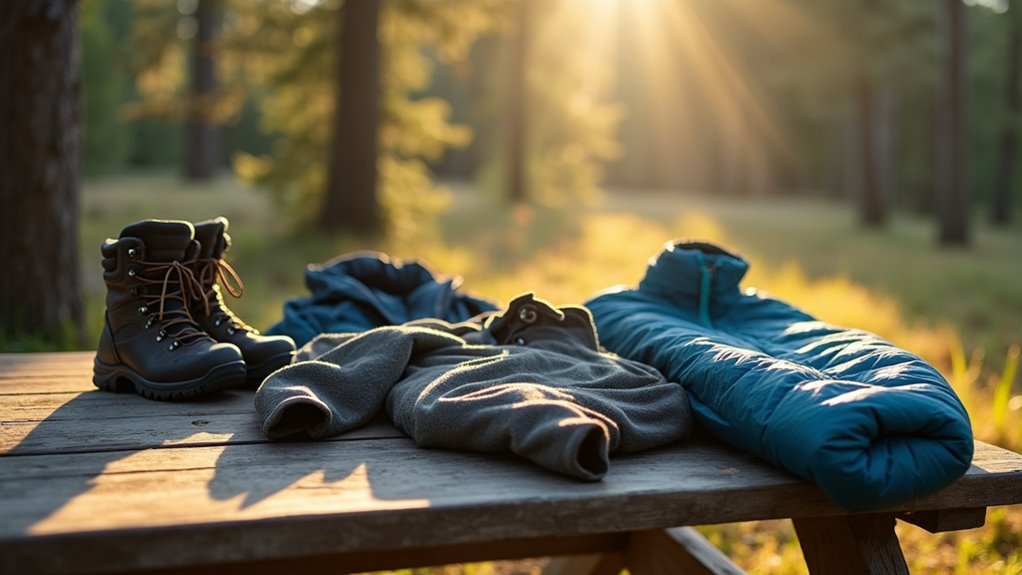
Since weather can change rapidly in the outdoors, you’ll want to pack clothing that adapts to various conditions rather than hoping for the best. Smart layering is your foundation – start with moisture-wicking base layers, add insulating mid-layers, and top with waterproof outer shells you can easily remove or add.
Smart layering beats wishful thinking when Mother Nature throws curveballs – adaptable clothing systems keep you comfortable whatever the conditions.
Don’t forget these essentials that’ll keep you comfortable and safe:
When selecting your gear, focus on lightweight options that serve multiple purposes to reduce the overall weight of your pack without sacrificing safety or comfort.
While you might be tempted to wing it with trail mix and granola bars, thoughtful meal planning will transform your camping experience from merely surviving to actually thriving in the wilderness. Start by mapping out each meal and snack, considering your group’s dietary needs and cooking equipment limitations.
Pre-cut vegetables, marinate proteins, and pack ingredients in labeled bags to streamline campsite cooking.
Invest in quality food storage containers that’ll keep critters out and freshness in. Hard-sided coolers work best for car camping, while backpackers need lightweight, bear-resistant canisters.
Don’t forget a reliable camp stove and backup fuel. Pack more water than you think you’ll need, and always bring water purification tablets as insurance.
A camping kettle provides versatility for boiling water quickly, making hot beverages, and preparing simple meals at your campsite.
Smart food planning prevents hunger-induced camping disasters.
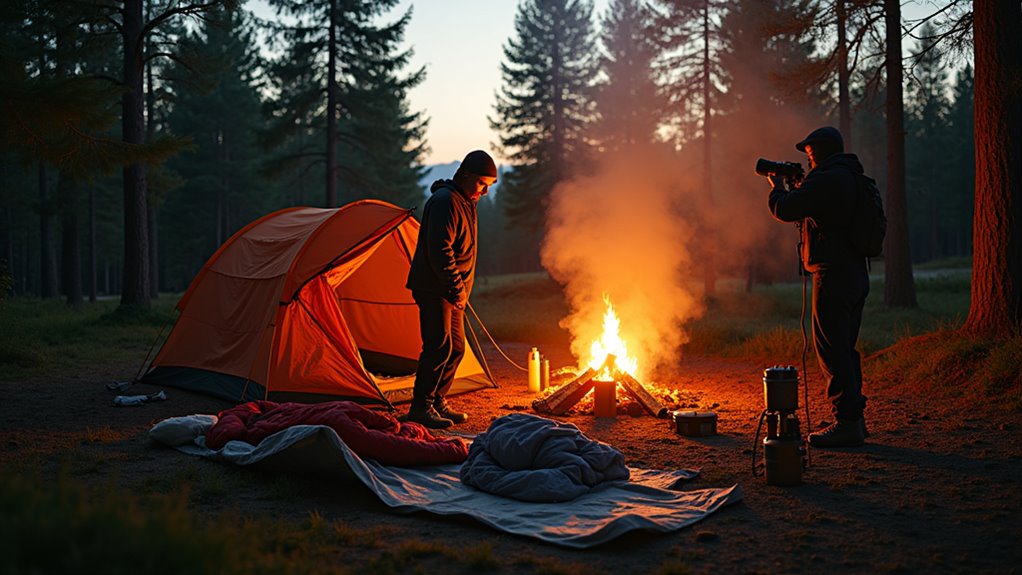
Even experienced campers can find themselves fumbling with tent poles and headlamps when darkness creeps in unexpectedly. You’ll want to arrive at your campsite with at least two hours of daylight remaining. This gives you ample time to set up your tent, organize gear, and familiarize yourself with your surroundings.
Start by choosing level ground away from potential hazards like dead branches or water runoff areas. Set up your tent first, then arrange other essentials within easy reach. Following these essential tent tips will help ensure your camping experience gets off to the right start.
Choose level ground away from hazards, pitch your tent first, then position essentials nearby for quick access.
Key benefits of early setup:
Once you’ve got your campsite established and organized, you’ll want to make sure you’re prepared for the unexpected repairs that camping inevitably brings. Pack a basic toolkit with essentials like duct tape, zip ties, and a multi-tool. These three items alone can fix most common camping mishaps, from torn tent fabric to broken gear straps.
Don’t forget rope or paracord for securing tarps or replacing broken guy-lines. Include a small sewing kit for fabric repairs and super glue for quick fixes on hard materials.
Pack extra batteries for headlamps and lanterns, plus backup tent stakes since they’re easily lost or bent.
Keep everything organized in a dedicated repair pouch so you can find what you need quickly when problems arise. Having your repair kit ready ensures you can focus on enjoying family camping activities without worrying about equipment failures disrupting your fun.
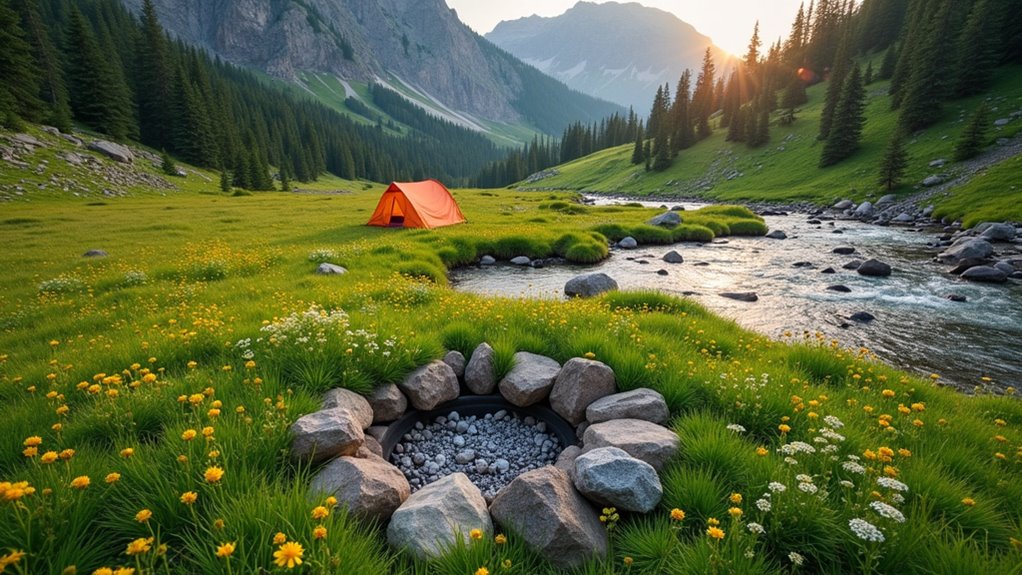
After you’ve mastered the practical aspects of camping, it’s time to focus on protecting the wilderness that makes your outdoor adventures possible. Leave No Trace principles aren’t just rules—they’re your commitment to preserving nature for future generations.
These seven principles guide responsible outdoor recreation: plan ahead, travel on durable surfaces, dispose of waste properly, leave what you find, minimize campfire impacts, respect wildlife, and be considerate of other visitors.
Following these guidelines ensures:
You’re not just camping—you’re becoming a wilderness steward.
Being a responsible wilderness steward means preparing yourself to handle whatever nature throws your way. Weather can shift dramatically in minutes, turning sunny skies into dangerous storms. Pack layers for temperature swings and waterproof gear for unexpected rain. Always check forecasts before departing, but don’t rely solely on predictions.
Create an emergency action plan. Tell someone your exact location, planned route, and expected return time. Pack a well-stocked first aid kit and know how to use it. Carry emergency communication devices like whistles, mirrors, or satellite messengers for remote areas.
Practice setting up your shelter quickly in various conditions. Know signs of hypothermia, heat exhaustion, and dehydration. Pack extra food, water, and batteries. Following low impact camping principles ensures you’re prepared while minimizing your environmental footprint during emergencies. You’ll feel confident tackling adventures when you’re prepared for nature’s curveballs.
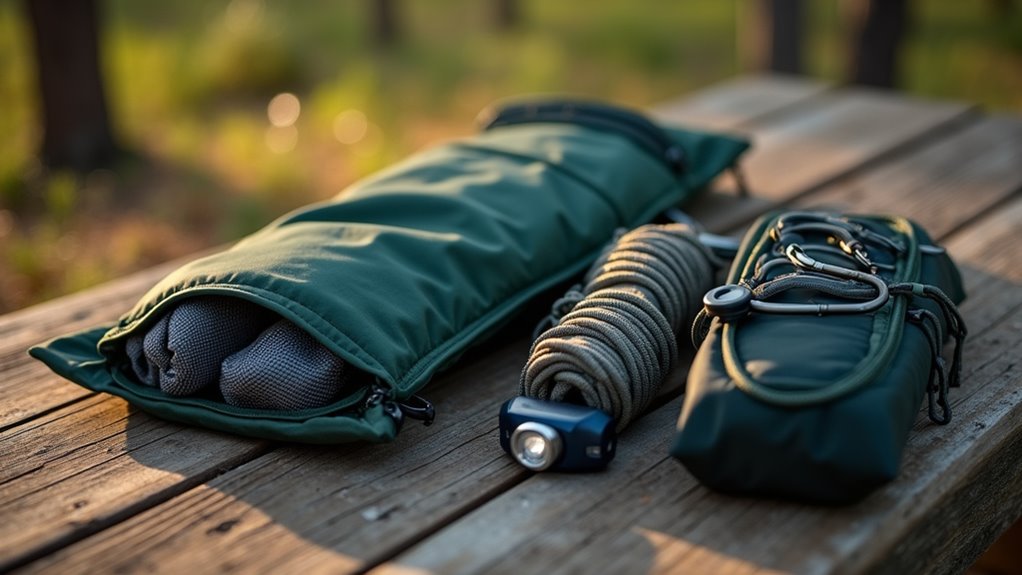
When you’re fumbling through a chaotic pack searching for your headlamp at dusk, you’ll quickly realize that smart gear organization isn’t just convenient—it’s essential for safety and sanity on the trail.
Start by categorizing your items into logical groups. Use packing cubes or stuff sacks to separate clothing, cooking gear, and toiletries. Keep frequently needed items like snacks, maps, and first aid supplies in easily accessible outer pockets.
Label everything clearly and maintain the same organizational system throughout your trip.
Having your gear perfectly organized won’t matter if your tent zippers jam or your stove refuses to light when you need them most. That’s why you’ll want to test everything before leaving home.
Well-organized gear means nothing when critical equipment fails at the worst possible moment in the wilderness.
Set up your tent in the backyard to check for missing stakes or damaged poles. Fire up your camping stove and lanterns to ensure they’re working properly. Test your water filter, headlamp batteries, and sleeping bag zippers.
Don’t forget to check your first aid supplies and replace any expired items.
This pre-trip testing might seem tedious, but it’ll save you from serious headaches at your campsite. You’ll catch problems while you can still fix or replace faulty gear, ensuring your adventure stays enjoyable instead of turning into a frustrating equipment disaster.
If you’re considering a motorhome for your next adventure, attending Britain’s Motorhome Show can provide valuable insights into the latest equipment and innovations before making your investment.
You’ve got the blueprint for camping glory—now don’t mess it up! Sure, you could ignore these tips and become that legendary camper who sets their tent on fire while getting lost in a thunderstorm without batteries. But you’re smarter than that, right? Pack smart, respect nature, and test your gear unless you enjoy sleeping under the stars because your tent collapsed. You’ve got this—just don’t prove us wrong!